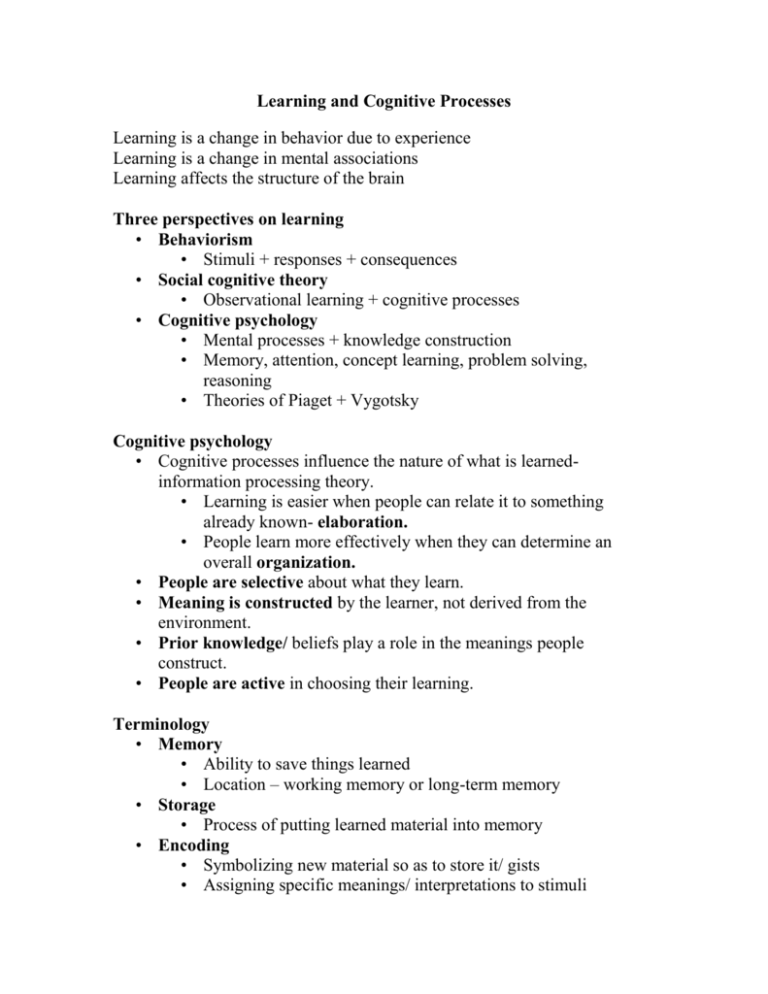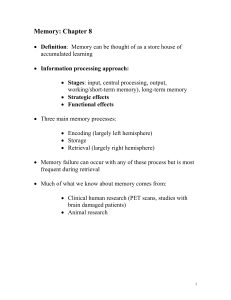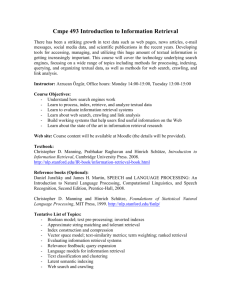Learning and Cognitive Processes
advertisement

Learning and Cognitive Processes Learning is a change in behavior due to experience Learning is a change in mental associations Learning affects the structure of the brain Three perspectives on learning • Behaviorism • Stimuli + responses + consequences • Social cognitive theory • Observational learning + cognitive processes • Cognitive psychology • Mental processes + knowledge construction • Memory, attention, concept learning, problem solving, reasoning • Theories of Piaget + Vygotsky Cognitive psychology • Cognitive processes influence the nature of what is learnedinformation processing theory. • Learning is easier when people can relate it to something already known- elaboration. • People learn more effectively when they can determine an overall organization. • People are selective about what they learn. • Meaning is constructed by the learner, not derived from the environment. • Prior knowledge/ beliefs play a role in the meanings people construct. • People are active in choosing their learning. Terminology • Memory • Ability to save things learned • Location – working memory or long-term memory • Storage • Process of putting learned material into memory • Encoding • Symbolizing new material so as to store it/ gists • Assigning specific meanings/ interpretations to stimuli • Retrieval • Process of finding information and remembering it Components of memory • Sensory register • Working memory • Long-term memory Sensory register • Holds everything you are exposed to briefly (less than a second or two) • Requires transfer of information to working memory to hold it • Attention is essential to moving information to working memory. • Attention has a limited capacity • 2 – 3 well learned tasks can be attended to at once • Only one difficult, complex task can be attended to effectively • Cocktail party phenomenon Enhancing attention in class • Ask questions to test understanding • Put the new material to use- solve a problem using the new information • Encourage note taking • Seat inattentive students nearer the teacher • Keep class stimulating using novel, varied methods of instruction, showing our own enthusiasm • Take regular breaks, do physical activities Working or Short-term memory • The work bench of the memory system • Where most thinking, cognitive processing occurs • 5 – 20 seconds unless rehearsed • Chunking helps • Keeping information in 5 – 9 bits • Organizing information • Helping them prioritize what is most important • Connecting information with prior knowledge Long-term memory • Holds information indefinitely • General knowledge + autobiographical information + performance knowledge • Unlimited capacity- the more that is stored, the easier it is to learn new things • Rich network of interconnections Forms of declarative knowledge • Verbal- words • Imagery- how information appears • Semantically – by meaning, gists Forms of procedural knowledge • Riding a bike • Multiplication steps • Steps in driving safely • Different ways of responding in different circumstances Information is held in many forms • For maximum retrieval, encode information in a variety of ways: • Visual + imagery • Visual + tactile • Auditory + graphs, charts • Music + pictures • Music + dances, hand signals Ways of learning declarative knowledge • Rehearsal • Rehearsing information verbatim – rote learning (not effective) • Meaningful learning • Finding a relationship between new information and information already stored in LTM (effective) • Organization • Making connections between many new pieces of information • Elaboration • Adding additional ideas to new information based on what one already knows • Visual imagery • Forming a mental picture of information Meaningful learning • The student has a meaningful learning set. • The student has previous knowledge to which the new information can be related. • The student is aware that previously learned information is related to new information. • The teacher must help the student make these connections. Organization • Organization means making connections among various pieces of new information, as well as making connections with existing knowledge. • Teachers can help by organizing new information for the student. • Organized material is learned at a rate of 70%. • Unorganized material is learned at a rate of 20%. • Draw students’ attention to the organizational structure. Elaboration • Using prior knowledge to expand on a new idea, so as to store more information than was presented. • Ask questions such as: • Why do you think this happens? • Can you think of examples of this concept? • How could we use this idea in our lives? • Have students talk about a topic among themselves, or come up with a solution to a problem together. Visual imagery • Visual imagery is forming mental pictures of ideas or objects. • Ask students to imagine how certain events might have looked. • Provide visual materials that illustrate important, even abstract ideas. • Ask students to draw their own illustrations, diagrams of things they are learning. Developing Procedural Knowledge • First offer declarative knowledge about the process. • Demonstrate or show pictures of the steps. • Verbalize mental procedures in a complex task. • Use verbal rehearsal as they learn a new skill. • Let them practice, give them feedback. • Break complex procedures into smaller tasks. Mnemonics • Verbal mediation- word/ phrase that creates a bridge (logical connection bet/ 2 pieces of information) • Au means ‘gold’: “Ay, you stole my gold watch!” • Keyword method- makes a connection between 2 things • Identify an object to represent each piece of info • Form a picture of both objects together • Superimposed meaningful structures- superimposing some meaningful organization on new information • Great Lakes- HOMES Long-Term Memory Retrieval • Retrieval is a process of following a pathway of associations. • Ease of retrieval depends on how logically the information has been stored, how well organized it is, and how well associated it is with other information. Semantic network model of associations • Semantic networks are organized through associations- Clustering. • When you activate one concept, it can trigger numbers of associations & concepts that spread through the entire network. Some links are stronger than others. Factors that promote retrieval • Making multiple connections with existing knowledge • Learning information to mastery & beyond • Using knowledge frequently • Having a relevant retrieval cue How can teachers aid retrieval? • Help students find ways to: • relate concepts in the same subject area • relate concepts to other subject areas • Relate concepts to students’ general knowledge • Relate to students’ personal experiences • Relate to Students’ current activities & personal needs • The more interrelationships a student forms among information, the more easily it is retrieved. • Offer many opportunities to practice skills until they achieve automaticity. Then retrieval is effortless. It frees up working memory space. • Offer class activities that incorporate old learned material along with new material. • Spaced reviews • Offer relevant retrieval cues, mnemonics. • Recognition tasks are easier than recall tasks. Forgetting • Failure to retrieve • Not enough retrieval cues, information is lost in the network • Reconstruction error • Can only retrieve part of the information, fill in gaps ‘logically’ • Interference • Proactive vs. retroactive interference of information • Decay • Bits of information deteriorate over time when not used • Failure to store • Information was not attended to & stored well in the beginning Retroactive vs. Proactive interference • Pieces of information in similar areas get mixed up during retrieval. • This is especially a problem when information is learned by rote, not connected meaningfully. Effects of increasing wait time • When teachers ask questions, they usually wait one second or less for a response. • If there is no response, teachers will often answer their own questions, or ask a related question. • Retrieval from LTM takes longer than 1 second. • If teachers increase it to 3 seconds, there is: • More class participation • Better quality of responses • Better classroom performance Increasing wait time affects teachers • They ask different kinds of questions, not so many simple questions • Increases flexibility in teaching- adapts to students’ comments, moves instruction in a direction the students show interest • It builds higher expectations for students. • It allows for deeper processing. • It changes the nature of discussions.







